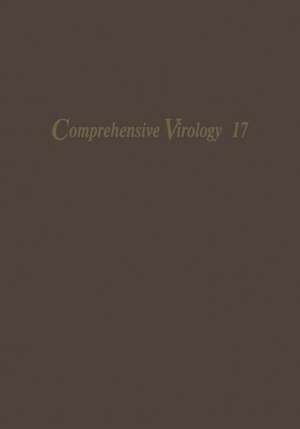Comprehensive Virology: 17 Methods Used in the Study of Viruses
Autor Heinz Fraenkel-Conrat, Robert R. Wagneren Limba Engleză Paperback – 15 apr 2012
Preț: 405.48 lei
Nou
Puncte Express: 608
Preț estimativ în valută:
77.61€ • 79.98$ • 65.52£
77.61€ • 79.98$ • 65.52£
Carte tipărită la comandă
Livrare economică 01-15 martie
Preluare comenzi: 021 569.72.76
Specificații
ISBN-13: 9781461566953
ISBN-10: 1461566959
Pagini: 480
Ilustrații: 480 p. 16 illus.
Dimensiuni: 178 x 254 x 25 mm
Greutate: 0.83 kg
Ediția:Softcover reprint of the original 1st ed. 1981
Editura: Springer Us
Colecția Springer
Locul publicării:New York, NY, United States
ISBN-10: 1461566959
Pagini: 480
Ilustrații: 480 p. 16 illus.
Dimensiuni: 178 x 254 x 25 mm
Greutate: 0.83 kg
Ediția:Softcover reprint of the original 1st ed. 1981
Editura: Springer Us
Colecția Springer
Locul publicării:New York, NY, United States
Public țintă
ResearchCuprins
1 Biophysical Methods in Virus Research.- 1. Introduction.- 2. Viscosity.- 3. Diffusion.- 4. Centrifugation.- 5. Sedimentation Equilibrium.- 6. Chromatography.- 7. Electrophoresis.- 8. Osmotic Pressure.- 9. Light Scatter.- 10. Theory of Electron Microscopy.- 11. References.- 2 Use of Electron Microscopy in Virology.- 1. Introduction.- 2. Specimen Methods.- 3. Survey of Results.- 4. Conclusion.- 5. References.- 3 Structural Studies of Viruses with X-Rays and Neutrons.- 1. Introduction.- 2. Physical Basis of X-Ray and Neutron Scattering.- 3. Structures of Spherical Viruses.- 4. Helicoidal Viruses.- 5. Conclusions.- 6. References.- 4 Serological Methods in the Identification and Characterization of Viruses.- 1. Introduction.- 2. Reagents.- 3. Neutralization.- 4. Agglutination.- 5. Precipitation.- 6. Tests with Labeled Antibodies.- 7. Complement Fixation.- 8. Immunoelectron Microscopy.- 9. Applications of Serological Methods.- 10. References.- 5 Chemical Modification of Viruses.- 1. Introduction.- 2. Reagents Used for Virus Modification.- 3. Modifications for Specific Purposes.- 4. Conclusions.- 5. References.- 6 Photobiology of RNA Viruses.- 1. Introduction.- 2. Plant Viruses.- 3. RNA Bacteriophages.- 4. Animal Viruses.- 5. Conclusion.- 6. References.- 7 The Photobiology of the DNA Viruses ?,T4, and ?X174.- 1. Introduction.- 2. ? Phage.- 3. UV Effects on Bacteriophage T4 (T2 and T6).- 4. UV Effects on ?X174.- 5. Conclusion.- 6. References.












